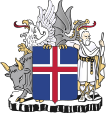| Politics of Iceland |
|---|
 |
|
Government
|
|
Legislature
|
|
Executive |
| Judiciary |
|
Elections
|
| Political parties |
| Administrative divisions |
| Foreign relations |
|
|
Parliamentary elections were held in Iceland on 10 September 1914. They were the last parliamentary elections in which only men could vote.
Electoral system
The 30 elected members of the Althing were elected from single or double member constituencies by first-past-the-post voting, with six members appointed to the upper house by the Danish monarch. Suffrage was limited to men aged 25 or over and who met one of several set requirements including being a civil servant, holding a medical (or similar) degree, being a graduate of a university or seminary, or paying tax of at least four króna (or for farmers, any level of tax), and who were not in receipt of poor relief.
Results
7,475 of the 13,400 registered voters participated in the elections.
References
- ^ "Participation in general elections to the Althingi". Statistics Iceland.
- Arend Lijphart & Bernard Grofman (2007). The Evolution of Electoral and Party Systems in the Nordic Countries. Algora Publishing. p. 103. ISBN 978-0-87586-168-5.
- ^ Daniele Caramani (2017). Elections in Western Europe 1815–1996. Springer. p. 518. ISBN 978-1-349-65508-3.
- Dieter Nohlen & Philip Stöver (2010) Elections in Europe: A data handbook, p963 ISBN 978-3-8329-5609-7
| Parliamentary elections |
|
|---|---|
| Presidential elections | |
| Municipal elections | |
| Referendums | |
| Constitutional Assembly | |